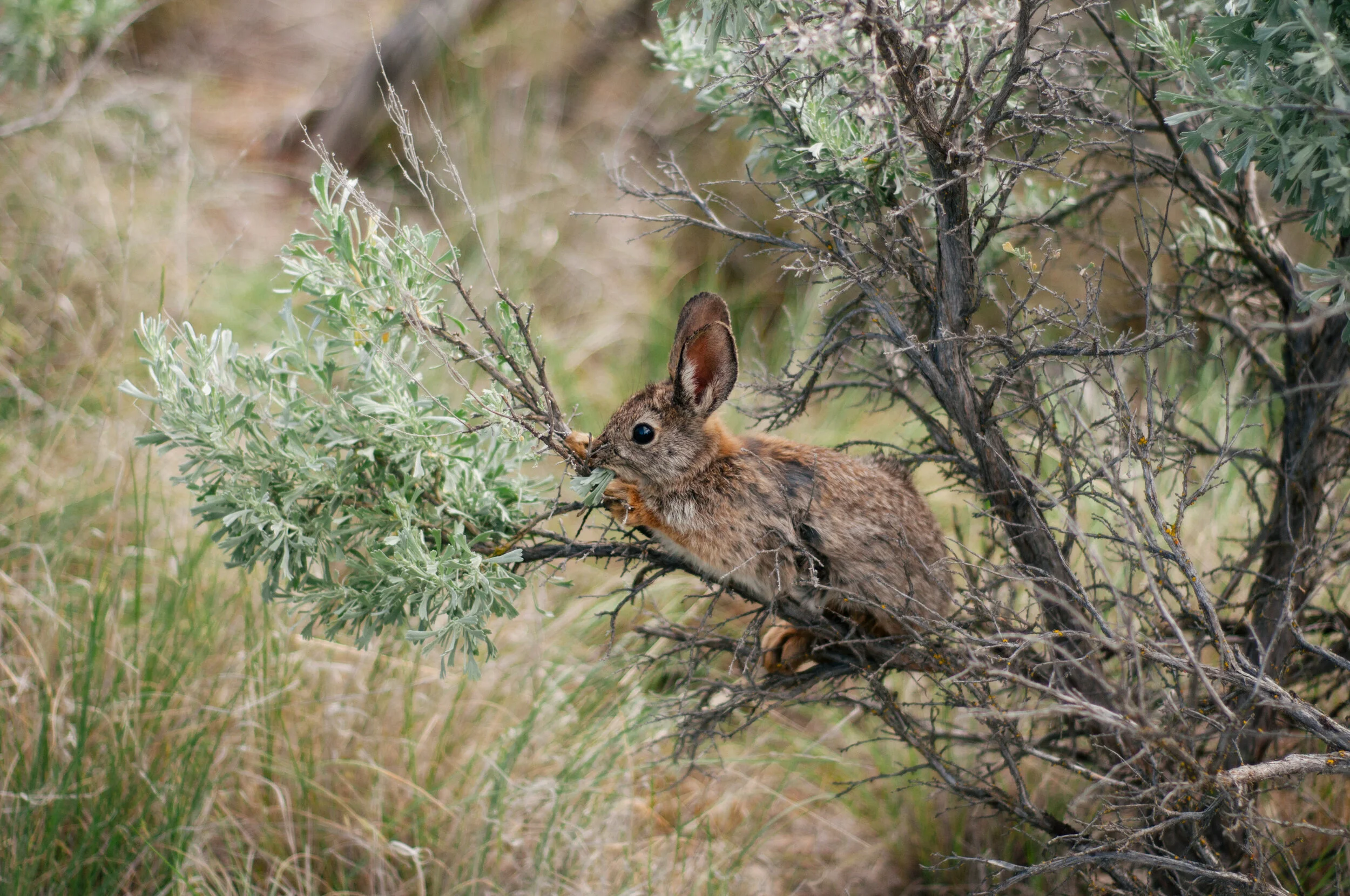By Corinna Hanson, Moses Coulee Land Manager, and Debra Crespin, Associate Director of Philanthropy
A new gift of land to The Nature Conservancy, 282 acres near Quincy, will help secure a future for tiny endangered pygmy rabbits.
The gift comes from Peter Lancaster and the estate of his friend Paul Schuster, buddies who shared a passion for the fragile sagebrush covered lands near where they grew up in Wenatchee. They loved the landscape and the wildlife that inhabited the shrub-steppe, especially pygmy rabbits, the smallest species of rabbit in North America, which has hovered on the edge of extinction for decades.
A pygmy rabbit crouches near the entrance to its burrow. © Hannah Letinich
Some 25 years ago they purchased 282 acres in Grant County in the heart of the area designated as a critical part of the Pygmy Rabbit Recovery Emphasis Area identified by the U.S. Fish & Wildlife Service (USFWS) and Washington Department of Fish and Wildlife (WDFW).
The land will become part of our existing Beezley Hills Preserve.
The Nature Conservancy has an active partnership with WDFW to conserve pygmy rabbits by providing suitable habitat and release sites, engaging volunteers to assist with pygmy rabbit conservation and release efforts, and offering temporary housing for staff and researchers at the Moses Coulee Field Station.
Peter Lancaster prepares to release a pygmy rabbit into the wild at Beezley Hills. Photo used with permission: Rich Landers / The Spokesman-Review
Peter has volunteered for decades to assist in the recovery program, offering this land for both semi-wild rearing efforts and for release of rabbits. Paul’s death in a tragic accident last year spurred Peter to seek permanent protection of the land with the Conservancy. We’re incredibly grateful for Peter and Paul’s commitment to this land and to the recovery of the pygmy rabbits.
A pygmy rabbit is gently held by a volunteer as it’s being readied for release. © Hannah Letinich
Pygmy rabbits have been devastated by wildfires in recent years, most recently by the Pearl Hill fire of 2020 and the Sutherland Canyon fire of 2017. Significant areas of habitat across their range were destroyed and many rabbits were lost in both fires. In the Pearl Hill fire of 2020, WDFW reported in addition to roughly 1,000 acres of habitat destroyed they lost breeding enclosures and release/acclimation pens as well as an unknown number of wild/free ranging rabbits.
This makes the Lancaster/Schuster gift of land even more important, as it is high quality habitat and is in the heart of the recovery area. We’ll be able to provide stewardship and habitat restoration to work for pygmy rabbits’ long-term survival; and we look forward to bringing volunteers out to assist in pygmy rabbit release activities as our volunteer program re-opens as we recover from the COVID-19 pandemic.
Tiny Rabbits spurred a lifelong fascination
Peter Lancaster shared with us his story of how he became enamored of the pygmy rabbits:
I grew up in East Wenatchee, Washington, near the boundary where orchards ended and sage began. Even before I started school rabbits had captured my imagination.
After the first snowfall, White-tail Jackrabbits often left visible evidence that they had crossed our yard. If I saw rabbit tracks, my mind worked overtime, stunned by the fact that a rabbit had visited our house while I slept.
Peter Lancaster
In truth, jackrabbits were my first love. When I became old enough to walk in hills nearby, I saw my first Nuttall’s cottontail. I became engrossed with them as well.
When I was 12, two of my childhood friends and I camped in the sage during spring break. One morning, we saw a rabbit-like kit dart into a clump of sage. We surrounded it. At almost the same time, we all blurted out, “Pika!” It then disappeared into a hole, with no white tail displayed.
I spent years trying to understand what I had seen. I researched whether ice-age refugia may have existed where pikas could have adapted to life in the sage. The mystery was solved when I saw my first pygmy rabbit kit. That’s what I had seen so many years before in the sage five miles from our house.
Pygmy rabbit kits and pikas certainly bear a resemblance. I still get a thrill thinking about it.
A snapshot of Peter Lancaster and Paul Schuster in the Serengeti. The two shared a love for wildlife both large and small. Photo courtesy of Peter Lancaster.
About the Land
The Beezley Hills Preserve is located in the heart of the unceded ancestral homelands of the škwáxčənəxʷ (Sinkaiuse) people, known today as the Moses Columbia Tribe. This landscape was also utilized and cared for by the neighboring šnp̓əšqʷáw̓šəxʷ (P’squosa) people, known today as the Wenatchi/Wenatshapam Tribe.
The Moses Columbia and Wenatchi tribes are two of the twelve constituent tribes of the present-day federally recognized Confederated Tribes of the Colville Reservation. The Wenatshapam (Wenatchi) are also one of the 14 bands that comprise the Confederated Tribes and Bands of the Yakama Nation. The Pisquouse, another of the 14 signatory tribes of the Yakama Nation, consider the Beezley Hills landscape part of their traditional homelands. They stewarded the entire land base, from the lowlands around the Columbia River to the snow-peaked Cascade Mountains.
The entire Beezley Hills Preserve is within an area ceded by the Yakama people to the federal government under the Treaty of 1855, in which Yakama tribal members retained their rights to continue to conduct practices in their Usual and Accustomed places across public lands.
Banner photo © Hannah Letinich























